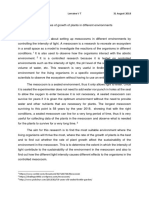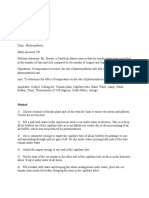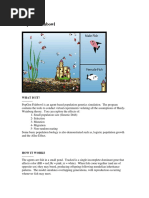Duckweed Temperature Lab
Uploaded by
kmjeezDuckweed Temperature Lab
Uploaded by
kmjeezDuckweed Temperature Lab
The purpose of this experiment was to test if duckweed fronds would grow faster in
hotter temperatures. We hypothesized duckweed plants grown in higher temperatures will have a
larger population size than duckweed plants grown in lower temperatures.
Duckweed, (or lemna minor), is an aquatic plant that reproduces rapidly and asexually.
Duckweed possess many useful traits that make it an excellent model organism to study
population growth. For example, it reproduces quickly, requires minimal space to grow, and
requires no maintenance.
First, we put 100mL of water each into 3 different test tubes to make sure everything was
the same exact temperature. Second, we put 5 fronds into all the test tubes, again maintaining
similarity. Third, once the saran wrap was over top, we put them in three different temperature
settings, to check how it would affect their growth.
To obtain data for population growth, we counted the number of duckweed fronds twice a
week and made observations about each frond’s growth and health by counting the fronds and
checking the color.
Results
Duckweed population in the 115F died almost immediately, turning white by the time we
checked. Alternatively, duckweed population in 95F increased slowly from 5 fronds to 13.
Furthermore, duckweed population in room temperature grew the fastest from 5 fronds to 14.
Table 1.
Day Number Date Population Count
0 8/29 5 5 5
5 9/3 6 8 5
8 9/6 7 9 5
11 9/9 11 9 5
15 9/13 13 14 5
Discussion
We found that hotter temperatures kill or slow down growth. Based on the results, the
data reject our hypothesis that duckweed plants grown in higher temperatures will have a larger
population size than duckweed plants grown in lower temperatures.
We should have expected the heat to fry the duckweed to death, as Mr. Vang needed and
incubator for it to reach the right level.
We lost one test tube, but that wasn’t our fault. We didn’t poke holes in the saran wrap,
so the duckweed might not have gotten an appropriate amount of air. Their quick death might
have been partially due to a lack of air.
Some limitations would be the lack of a larger test space. Not as many could have grown,
due to the crowded nature. The water was also bottled, which means it didn’t have the same
quality and nutrients in lake water.
For future reference, you could use beakers instead. They are larger, lay flat without
stands, and still clear. Lake water might be harder to come by, but you could supply non-filtered
water to use for tests.
You might also like
- (Amy Stewart) The Drunken Botanist The Plants Tha0% (1)(Amy Stewart) The Drunken Botanist The Plants Tha3 pages
- Declaration of Kirk Schroeder in Support of Plaintiffs' Motion For Preliminary InjunctionNo ratings yetDeclaration of Kirk Schroeder in Support of Plaintiffs' Motion For Preliminary Injunction34 pages
- Biology Report Vincent Schelwald 333132 Duckweed Experiment Group 1 Aandrei Petya Ruben FortuneNo ratings yetBiology Report Vincent Schelwald 333132 Duckweed Experiment Group 1 Aandrei Petya Ruben Fortune8 pages
- Duckweeds: 3. Floating Aquatic MacrophytesNo ratings yetDuckweeds: 3. Floating Aquatic Macrophytes24 pages
- Survival Strategies of Duckweeds The Worlds (Ziegler, 2023)No ratings yetSurvival Strategies of Duckweeds The Worlds (Ziegler, 2023)30 pages
- Growth Limitation of Lemna Minor Due To High Plant Density - ResearchGateNo ratings yetGrowth Limitation of Lemna Minor Due To High Plant Density - ResearchGate14 pages
- What Is The Effect of Increasing Iron (III) Chloride Concentration (0 MG - L, 2mg - L, 4mg - L, 6mg - L, 8mgNo ratings yetWhat Is The Effect of Increasing Iron (III) Chloride Concentration (0 MG - L, 2mg - L, 4mg - L, 6mg - L, 8mg15 pages
- Measurement of the Effects of Liquid Fertilizers at the Different Levels on Duckweed Lemna Minor L. Growth Using Image Analysis TechniqueNo ratings yetMeasurement of the Effects of Liquid Fertilizers at the Different Levels on Duckweed Lemna Minor L. Growth Using Image Analysis Technique6 pages
- What is the effect of increasing iron (III) chloride concentration (0 mg_L, 2mg_L, 4mg_L, 6mg_L, 8mgNo ratings yetWhat is the effect of increasing iron (III) chloride concentration (0 mg_L, 2mg_L, 4mg_L, 6mg_L, 8mg15 pages
- Pcculiarities Bdelloida) Growth and Reproduction Under Various Temperature ConditionsNo ratings yetPcculiarities Bdelloida) Growth and Reproduction Under Various Temperature Conditions17 pages
- Science Fair Project Plant Biology Can Water Plants Be Used To Determine Water Quality?No ratings yetScience Fair Project Plant Biology Can Water Plants Be Used To Determine Water Quality?4 pages
- (23279834 - HortScience) The Effect of Temperature On Leaf and Flower Development and Flower Longevity of Zygopetalum Redvale 'Fire Kiss' OrchidNo ratings yet(23279834 - HortScience) The Effect of Temperature On Leaf and Flower Development and Flower Longevity of Zygopetalum Redvale 'Fire Kiss' Orchid5 pages
- Koordinasi Ekonomi Hijau Dengan Lemna (Ishizawa, 2020)No ratings yetKoordinasi Ekonomi Hijau Dengan Lemna (Ishizawa, 2020)13 pages
- Effect On Growth Performance Broiler Chicken of Supplementing Rice Bran With DuckweedNo ratings yetEffect On Growth Performance Broiler Chicken of Supplementing Rice Bran With Duckweed13 pages
- Exercise 4 Environmental Parameters As Limiting Factors: Cornu Aspersum (Snails)No ratings yetExercise 4 Environmental Parameters As Limiting Factors: Cornu Aspersum (Snails)16 pages
- Light Color vs. Plant Growth: by David Lemcoe Biology Mr. JamesonNo ratings yetLight Color vs. Plant Growth: by David Lemcoe Biology Mr. Jameson4 pages
- Science Fair - Student Name - Form Class (2) 1 OfficialNo ratings yetScience Fair - Student Name - Form Class (2) 1 Official8 pages
- Reading - How Do Abiotic Factors Affect Biotic OrganismsNo ratings yetReading - How Do Abiotic Factors Affect Biotic Organisms2 pages
- Investigating Effect of Plant Mineral Deficiencies95% (20)Investigating Effect of Plant Mineral Deficiencies28 pages
- Ampayon, Butuan City, Agusan Del Norte: Caraga State UniversityNo ratings yetAmpayon, Butuan City, Agusan Del Norte: Caraga State University10 pages
- Year-Round Edible Gardening: Growing Vegetables and Herbs, Inside or Outside, in Every SeasonFrom EverandYear-Round Edible Gardening: Growing Vegetables and Herbs, Inside or Outside, in Every SeasonNo ratings yet
- Jea Verma & Heather Kim MYP 5 Science Fair 2023-2024No ratings yetJea Verma & Heather Kim MYP 5 Science Fair 2023-20241 page
- Yasmin Ruth M. Clima - Crop Science 1100 Lab 6No ratings yetYasmin Ruth M. Clima - Crop Science 1100 Lab 67 pages
- (FREE PDF Sample) The Impact of Peri-Urbanisation On Housing Development: Environmental Quality and Residents' Productivity in Ibeju-Lekki, Lagos 2nd Edition Dr. Adedirefunmilayo Mokunfayo Ebooks100% (12)(FREE PDF Sample) The Impact of Peri-Urbanisation On Housing Development: Environmental Quality and Residents' Productivity in Ibeju-Lekki, Lagos 2nd Edition Dr. Adedirefunmilayo Mokunfayo Ebooks47 pages
- Download (eBook PDF) Canada's Population in a Global Context An Introduction to Social Demography, 2nd Edition ebook All Chapters PDF100% (2)Download (eBook PDF) Canada's Population in a Global Context An Introduction to Social Demography, 2nd Edition ebook All Chapters PDF41 pages
- Domestic Water Demand Forecasting and Management Under Changing Socio-Economic ScenarioNo ratings yetDomestic Water Demand Forecasting and Management Under Changing Socio-Economic Scenario8 pages
- A206 Studiengangsinfo-Information About The Study Programme0% (1)A206 Studiengangsinfo-Information About The Study Programme132 pages
- B-M-PHD Dip Geog Course ALL 10 Sep 20 13 PDFNo ratings yetB-M-PHD Dip Geog Course ALL 10 Sep 20 13 PDF73 pages
- Question Paper Commerce Bba Semester-1 2019 November Business-Demography-2019-PatternNo ratings yetQuestion Paper Commerce Bba Semester-1 2019 November Business-Demography-2019-Pattern2 pages
- UEE J: Evaluation of New Towns Construction in The Around of Tehran MegacitiyNo ratings yetUEE J: Evaluation of New Towns Construction in The Around of Tehran Megacitiy9 pages
- Eng 11 - Revision For Final Test - 1 Semester IF2No ratings yetEng 11 - Revision For Final Test - 1 Semester IF215 pages
- Yangon, in The Context of Urbanization Process in Myanmar Trends, Problems & FutureNo ratings yetYangon, in The Context of Urbanization Process in Myanmar Trends, Problems & Future101 pages
- Class12 Biology Chapter 13. Organisms & Populations Class NotesNo ratings yetClass12 Biology Chapter 13. Organisms & Populations Class Notes9 pages
- Session 1 Conservation and Promotion of Heritage Values in Regional and Urban PlanningNo ratings yetSession 1 Conservation and Promotion of Heritage Values in Regional and Urban Planning413 pages

























































































